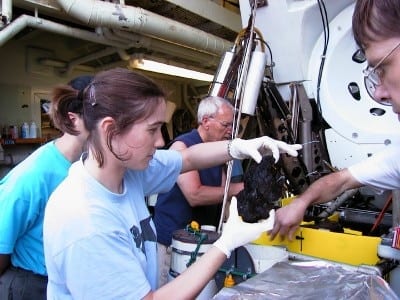Scientists Find Bacteria Thriving on a Feast of Seafloor Rock
May 28, 2008
On the deep ocean floor, microbial life is feeding on fresh volcanic rock and flourishing with greater abundance than even the most optimistic scientists thought possible. According to a study published May 28 in the journal Nature, scientists have found bacteria growing on oceanic crust in concentrations that are thousands- to ten-thousand times (three to four orders of magnitude) greater than what is found in the overlying waters.
Researchers collected and examined rock and water samples from the East Pacific Rise, the Nankai Trough, the Mid-Atlantic Ridge, the Sargasso Sea, and the seafloor near Hawaii. The research team—which included scientists from the Woods Hole Oceanographic Institution (WHOI), the University of Southern California (USC), the University of Bremen, Western Washington University, the Marine Biological Laboratory, and the Scripps Institution of Oceanography—used various molecular and genetic analysis tools (such as quantitative polymerase chain reaction and clone libraries) to quantify the abundance, richness, and diversity of communities of bacteria living on young ocean crust.
What they found was a community of microbes—growing without light and eating rocks—that is as fertile and prodigious as what can be found in terrestrial farm soil. Such seafloor microbes have been detected before, but this is the first time that they have been quantified.
“We were truly shocked to find microbial life thriving at the levels we observed,” said Cara Santelli, a recent graduate of the MIT/WHOI Joint Program in Oceanography and now a postdoctoral scholar at Harvard University. Santelli conducted the research with geochemists Katrina Edwards and Wolfgang Bach while all three were in Woods Hole. Edwards is now at USC, while Bach has moved to the University of Bremen.
“Theoretical research by Edwards and Bach had suggested that life could exist in such a dark, cold, and rocky environment,” said Santelli, lead author on the Nature paper. “The objective of our project was to provide tangible evidence. Not only was the biomass in seafloor lava greater than in the overlying seawater, but the bacterial diversity was significantly greater than we could have imagined.”
The findings open up new questions about the evolution of Earth and of seafloor life.
“We are just beginning to scratch the surface,” Santelli said. “What role does this microbial community play in global ocean chemistry? What sort of metabolism is needed to live in and dominate this environment? And what exactly are these microbes doing down there?”
The research by Santelli and Edwards, et al, was funded by the National Science Foundation’s Ridge 2000 program, the NASA Astrobiology Institute, and Western Washington University.
Related Links
» Nature magazine: Abundance and diversity of microbial life
in ocean crust
» NSF: Bacteria Feed on Ocean Bottom’s Crust
» Living Large in Microscopic Nooks
» Who is Cara Santelli?
» Who is Katrina Edwards?
» Formation of Lava Bubbles Offers New Insight into Seafloor
Formation

